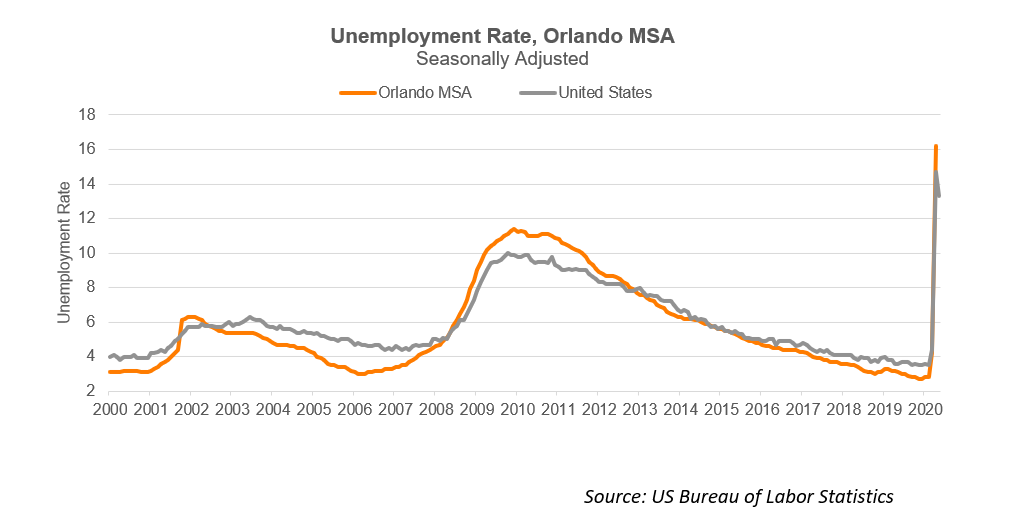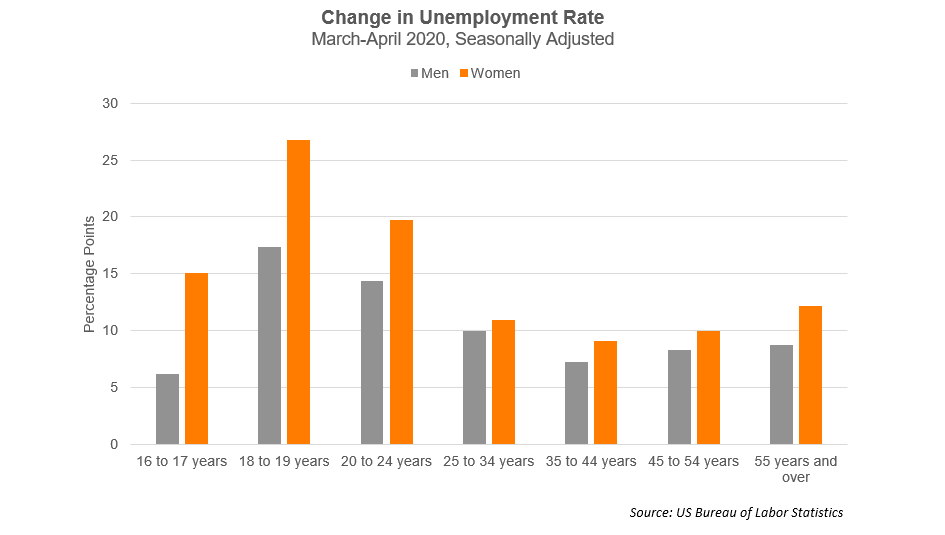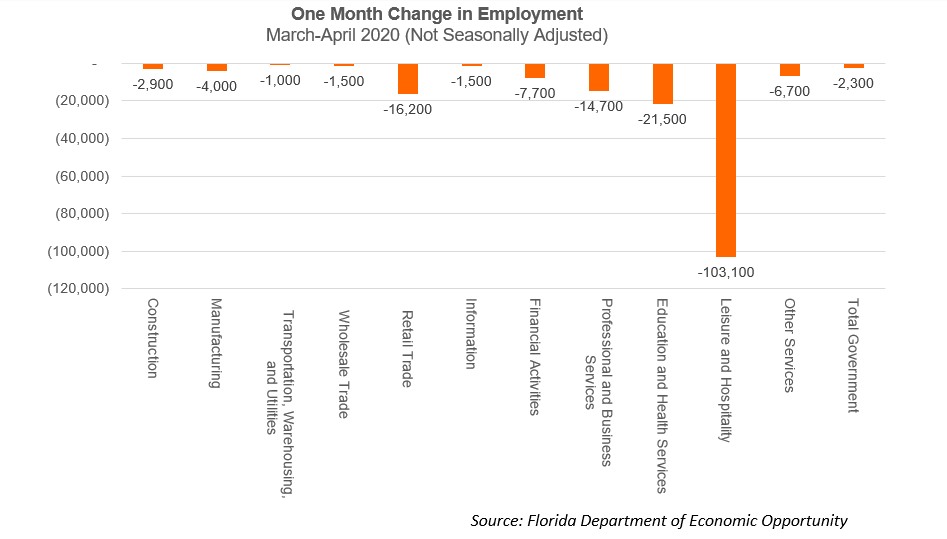Released the first week of every month, the Orlando Economic Update series dives into the most recent labor market and economic data to provide context and analysis on the changing market conditions within Central Florida.
Unemployment Rate Deep Dive
Orlando lost 183,200 jobs from March to April, equivalent to five years’ worth of job gains.
This fact and skyrocketing unemployment was the main takeaway from the most recent labor market data released by the Florida Department of Economic Opportunity on May 22. With the most recent release, the unemployment rate in Orlando rose to 16.2 percent, up 12 percentage points from the March rate of 4.2 percent. This equates to 203,000 unemployed individuals within the Orlando Metropolitan Statistical Area (MSA), which represents the area of Lake, Orange, Osceola and Seminole Counties. This data is in line with the sharp increases seen across the nation and state. Orlando’s unemployment rate is currently the highest of any Florida MSA and is higher than it was at any point during the 2008 recession.

In a national context, this puts the Orlando MSA in the top 50 percent of all 389 metropolitan areas with the highest unemployment rates and just below the 75 percentile. The highest unemployment rates in the country for April were recorded in Kahului, HI (35.0 percent) and Kokomo, IN (34.1 percent). The largest over-the-year increases in unemployment occurred in Kahului, HI (+32.5 percentage points), Las Vegas, NV (+29.5 percentage points), and Atlantic City, NJ (+29.1 percentage points).
Logan, UT-ID had the lowest unemployment rate at 6.2 percent, and no metropolitan area saw a decrease in unemployment.
Looking ahead, expect Orlando’s unemployment rate to decrease slightly with the release of May data on June 19. New data released today, June 5, put the US unemployment rate at 13.3 percent, an decrease of 1.4 percentage points. “In May, employment rose sharply in leisure and hospitality, construction, education and health services, and retail trade” across the country. This is good news for Orlando, which will mostly likely follow the national trend. The most recent metropolitan employment report from the BLS can be viewed here and the most recent National Employment Situation Report can be viewed here.
Young workers and women have been disproportionally impacted by COVID-19 related layoffs, with higher increases in the unemployment rate for women across the board, no matter the age group.

Overall women in the United States are facing an unemployment rate of 16.2 percent while the rate for men is 13.5 percent. The rates change depending on the age or demographic subgroup. Women who support their households, those without a spouse of any sex present, currently have an unemployment rate of 15.9 percent. The selected unemployment indicators can be found from the Bureau of Labor Statistics here.
These dynamics are partially due to the fact that women make up a larger percentage of the workforce in hard hit industries, such as Leisure and Hospitality. This industry includes restaurants, bars, theme parks, museums, hotels, etc. Women make up 52.4 percent of the industry workforce nationally and 51.6 percent in Orlando. It remains to be seen how different genders are impacted as some jobs begin to return while others do not, scarce childcare options, or by increasing trends in automation.
Industry Impacts
Leisure and hospitality accounted for most of Orlando’s job losses from March to April, with industry employment decreasing by 39 percent. Just under half (49 percent) of all jobs in restaurants and bars were lost (51,400 jobs). Overall, the Leisure and Hospitality industry now accounts for 14 percent of all employment in Orlando where it used to account for 20+ percent.
Every other industry was impacted, with month to month jobs losses in Construction, Manufacturing, Retail Trade, Education and Health, Business Services etc. Two sub industries of note: Hospitals saw an increase in employment while Real Estate, Rental and Leasing employment decreased by 21 percent (6,600 jobs) month-to-month.

The widespread nature of these job losses highlights the fact that no industry is immune to the impacts of this economic shock. While Orlando’s tourism economy creates specific exposure to decreased consumer spending, there are occupations in every industry and every town that are impacted when supply chains, consumers and markets are exposed to risk and uncertainty.
Employment changes by industry tell us less than occupation data would about where reemployment opportunities exist. Put another way, no industry is an employment haven. Instead, it is individual occupations and types of work, spanning all industries, that put regional economies at risk.
Current Opportunities
Even in the face of massive job losses, employers are still posting for specific positions and skills that are in high demand. Job posting data provides a sense of which companies are actively demanding new talent, and the top Orlando jobs in demand from March 20 – May 18, 2020 are included in the table below.
Top Jobs in Demand – Orlando MSA
Number of postings requesting skill from March 20-May 18, 2020
| Job Title | Job Postings | Orlando Average Wage* | Automation Risk** | Employers with Most Openings |
| Registered Nurses | 1,330 | $66,200 | 85.3 | AdventHealth, Orlando Regional Healthcare, Healthcare Travelers |
| Sales Representatives, Wholesale and Manufacturing, Except Scientific and Technical Products | 867 | $92,080 | 91.5 | Sentext, Century Link, State Farm Insurance Companies |
| Retail Salespersons | 833 | $26,800 | 93.4 | Lowe’s, Dollar General, CVS Health |
| First-Line Supervisors of Retail Sales Workers | 578 | $46,100 | 87.8 | Dollar General, CVS Health, Dollar Tree |
| Customer Service Representatives | 555 | $33,700 | 96.4 | Circle K, Walgreens Boots Alliance Inc, WaWa Incorporated |
| Heavy and Tractor-Trailer Truck Drivers | 472 | $42,000 | 110.1 | R.E. Garrison, C.R. England, Inc. Florida Rock & Tank Lines |
| Security Guards | 390 | $86,727 | 109.8 | Allied Universal Corporation, AlliedBarton Security Services, Securitas, Gardaworld |
| Managers, All Other | 386 | $99,200 | 84.5 | Lockheed Martin, Anthem Blue Cross, Tetra Tech, Siemens |
| Computer Occupations, All Other | 378 | $78,900 | 85.5 | Lockheed Martin Corporation, Deloitte, Anthem Blue Cross |
| Software Developers, Applications | 349 | $95,600 | 81.1 | Deloitte, Lockheed Martin Corporation, Northrop Grumman |
* JobsEQ 2019 Q4
** EMSI Automation Index. 100 = Average Risk of Automation
Source: Burning Glass Technologies, Skill Projections. Job Postings March 20 – May 18, 2020
Note, these positions are not all “future proof.” Some have high automation indexes, make low wages, or are simultaneously for positions that have been heavily impacted by COVID-19 layoffs (example, Retail Salespersons).
Controlling for these factors, however, reveals entirely new careers and skills that will emerge from the post COVID-19 economy. Tracking this data can help inform the development of talent pipelines used for economic recovery. Tactics such as skills-based hiring would promote key positions to a diverse audience. The Partnership recently presented a webinar expanding on how skill-based hiring can be used to diversify talent pools and for economic recovery.
Leading Indicator Overview
The data discussed above can be found on the Partnership’s COVID-19 Research Center in a publicly available deck that tracks the most recent, leading economic and labor market indicators for the region. Check back on this page weekly for updates and key takeaways that highlight Central Florida’s recovery position over the coming months.

